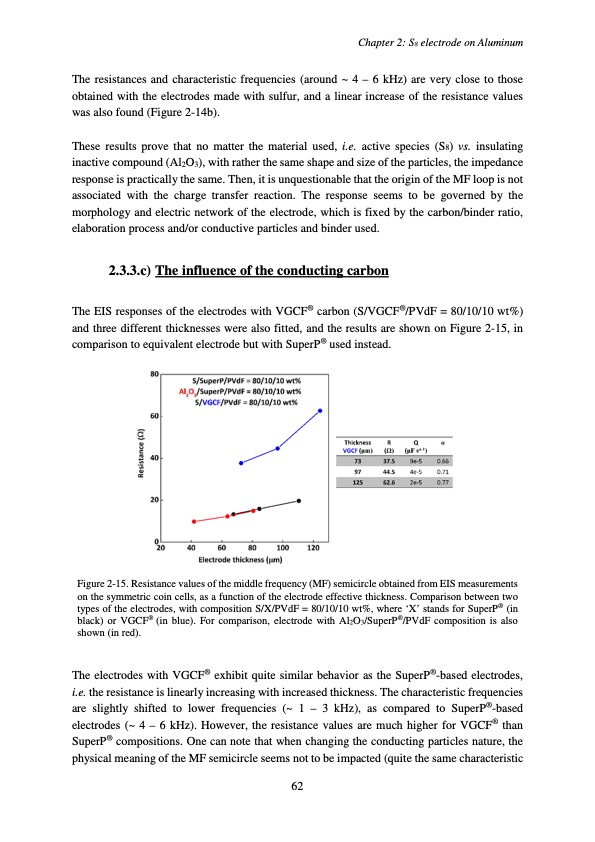
PDF Publication Title:
Text from PDF Page: 066
The resistances and characteristic frequencies (around ~ 4 – 6 kHz) are very close to those obtained with the electrodes made with sulfur, and a linear increase of the resistance values was also found (Figure 2-14b). These results prove that no matter the material used, i.e. active species (S8) vs. insulating inactive compound (Al2O3), with rather the same shape and size of the particles, the impedance response is practically the same. Then, it is unquestionable that the origin of the MF loop is not associated with the charge transfer reaction. The response seems to be governed by the morphology and electric network of the electrode, which is fixed by the carbon/binder ratio, elaboration process and/or conductive particles and binder used. 2.3.3.c) The influence of the conducting carbon The EIS responses of the electrodes with VGCF® carbon (S/VGCF®/PVdF = 80/10/10 wt%) and three different thicknesses were also fitted, and the results are shown on Figure 2-15, in comparison to equivalent electrode but with SuperP® used instead. Figure 2-15. Resistance values of the middle frequency (MF) semicircle obtained from EIS measurements on the symmetric coin cells, as a function of the electrode effective thickness. Comparison between two types of the electrodes, with composition S/X/PVdF = 80/10/10 wt%, where ‘X’ stands for SuperP® (in black) or VGCF® (in blue). For comparison, electrode with Al2O3/SuperP®/PVdF composition is also shown (in red). The electrodes with VGCF® exhibit quite similar behavior as the SuperP®-based electrodes, i.e. the resistance is linearly increasing with increased thickness. The characteristic frequencies are slightly shifted to lower frequencies (~ 1 – 3 kHz), as compared to SuperP®-based electrodes (~ 4 – 6 kHz). However, the resistance values are much higher for VGCF® than SuperP® compositions. One can note that when changing the conducting particles nature, the physical meaning of the MF semicircle seems not to be impacted (quite the same characteristic Chapter 2: S8 electrode on Aluminum 62PDF Image | Accumulateur Lithium Soufre

PDF Search Title:
Accumulateur Lithium SoufreOriginal File Name Searched:
WALUS_2015_archivage.pdfDIY PDF Search: Google It | Yahoo | Bing
Sulfur Deposition on Carbon Nanofibers using Supercritical CO2 Sulfur Deposition on Carbon Nanofibers using Supercritical CO2. Gamma sulfur also known as mother of pearl sulfur and nacreous sulfur... More Info
CO2 Organic Rankine Cycle Experimenter Platform The supercritical CO2 phase change system is both a heat pump and organic rankine cycle which can be used for those purposes and as a supercritical extractor for advanced subcritical and supercritical extraction technology. Uses include producing nanoparticles, precious metal CO2 extraction, lithium battery recycling, and other applications... More Info
| CONTACT TEL: 608-238-6001 Email: greg@infinityturbine.com | RSS | AMP |